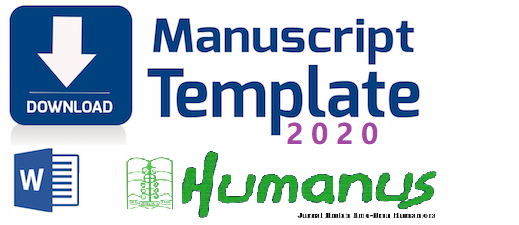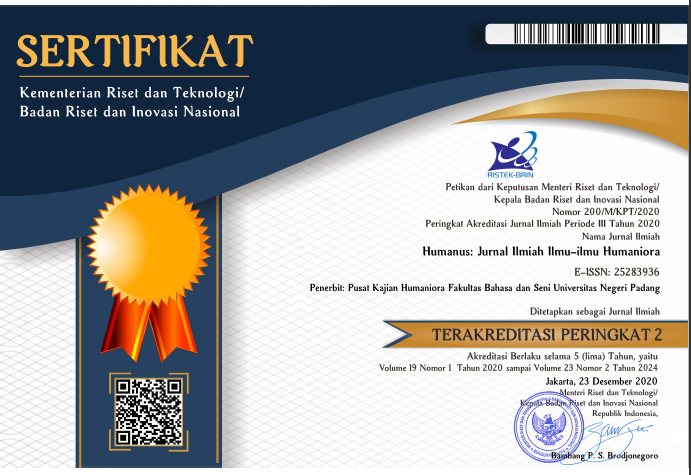Readibility, Meaning, and Function of Foreign Language on Billboards in Surakarta: A Critical Discourse Analysis
 ), Slamet Subiyantoro(2), Budhi Setiawan(3),
), Slamet Subiyantoro(2), Budhi Setiawan(3), (1) Universitas Sebelas Maret Surakarta
(2) Universitas Sebelas Maret Surakarta
(3) Universitas Sebelas Maret Surakarta
 Corresponding Author
Corresponding Author
Copyright (c) 2020 Humanus
DOI : https://doi.org/10.24036/humanus.v19i2.103806
Full Text:
 Language : en
Language : en
Abstract
This research aims to describe the use of foreign languages on billboards in Surakarta. This research was a single case study obtained from the objective data of billboards along Slamet Riyadi Street Surakarta. The data sources were from the commercial billboards considering several criteria that have been determined in which the billboards should not be owned by either district government or individual, for campaign purposes, made in 2018, and so on. Those billboards are billboard from Gofood, McDonald's, and Samsung Galaxy Note9. Subsequently, effective data were obtained through observation and interview from informants in readability process. Manifestation of billboard as a form of discourse generates meaning based on critical discourse analysis approach. In addition to the function of billboard as marketing aspect of the company, it also functions to deliver important information, knowledge, and educative information for the readers. This research results show that the readability, meaning, and function of foreign languages assumption on advertisement of billboard are different from the marketing concept. Nonetheless, an emergence of foreign languages provides space for the readers to learn the vocabulary in facing globalization era. Moreover, it also reminds us not to forget the existing culture in Surakarta.
Keywords
References
Ahn, J., Ferle, C. La, & Lee, D. (2016). Language and advertising effectiveness : code- switching in the Korean marketplace. International Journal of Advertising, 1–18. https://doi.org/10.1080/02650487.2015.1128869
Cahyani, D. A., & Islam, A. F. (2017). The ambiguity of English advertisement. Journal of English Language Teaching, 4(7), 52–65.
Fairclough, N. (1992). Discourse and social change. Great Britain: Blackwell Publishing Ltd.
Gebreselassie, A., & Bougie, R. (2018). The meaning and effectiveness of billboard advertising in least developed countries: The Case of Ethiopia. Journal of Promotion Management, 1–34. https://doi.org/10.1080/10496491.2018.1536618
Halliday, M. A. K., & Hasan, R. (1989). Language, Context, and Text_ Aspects of Language in a Social-Semiotic Perspective. (F. Christie, Ed.) (2nd ed.). Hongkong: Oxford University Press Inc.
Hornikx, J., & Meurs, F. Van. (2016). Foreign Languages in Advertising as Implicit Country-of-Origin Cues : Mechanism , Associations , and Effectiveness. Journal of International Consumer Marketing, 1–14. https://doi.org/10.1080/08961530.2016.1243996
Hornikx, J., Meurs, F. Van, & Hof, R. (2013). The Effectiveness of Foreign-Language Display in Advertising for Congruent versus Incongruent Products. Journal of International Consumer Marketing, 25(3), 152–165. https://doi.org/10.1080/08961530.2013.780451
Jere, M. G., & Dutuma, T. (2018). Determining the Factors Influencing Adoption of Interactive Digital Billboards in South Africa. In N. Malhotra & S. Burgess (Eds.), Proceedings of the 2018 Annual Conference of the Emerging Markets Conference Board (pp. 231–239). South Africa: University of the Witwatersrand Wits Business School.
Keysar, B., Hayakawa, S. L., & An, S. G. (2012). Psychological ScienceThe Foreign-Language Effect: Thinking in a Foreign Tongue Reduces Decision Biases. Psychological Science, 1–8. https://doi.org/10.1177/0956797611432178
Lusekelo, A., & Alphonce, C. (2018). The Linguistic Landscape of Urban Tanzania: An Account of the Language of Billbords and Shop-signs in District Headquaters. Journal of Language, Technology and Enterpreneurship in Africa, 9(1), 1–28.
Nederstigt, U., & Hilberink-schulpen, B. (2017). Advertising in a Foreign Language or the Consumers ’ Native Language ? Journal of International Consumer Marketing, 1–12. https://doi.org/10.1080/08961530.2017.1363008
Sesriyani, L. (2018). Cohesion and coherence in advertising discourse in the jakarta post of october - december 2018. Eduka: Jurnal Pendidikan, Hukum Dan Bisnis, 4(2), 48–60.
Tajuddin, S. N. A. A., & Zulkepli, N. (2019). An Investigation of the Use of Language, Social Identity and Multicultural Values for Nation-Building in Malaysian Outdoor Advertising. Social Sciences, 8(1), 18. https://doi.org/10.3390/socsci8010018
Tanskanen, S.-K. (2006). Collaborating towards Coherence. Amsterdam/ Philadelphia: John Benjamin Publishing Company.
 Article Metrics
Article Metrics
 Abstract Views : 341 times
Abstract Views : 341 times
 PDF Downloaded : 108 times
PDF Downloaded : 108 times
Refbacks
- There are currently no refbacks.
Copyright (c) 2020 Humanus

This work is licensed under a Creative Commons Attribution-NonCommercial 4.0 International License.










